Leonard Frederick ‘Leo’ Dixon was born, raised and educated in Chelmsford, the son of the town’s Mayor of 1919-1920. He became a school teacher at Trinity Road School, Chelmsford and joined the army in February 1916. He gained a commission as an officer and was killed in May 1918. His home was in Park Avenue.
DIXON, LEONARD FREDERICK,
Lieutenant, 11th Battalion, attached to 2nd Battalion, South Wales Borderers (formerly Essex Regiment)
The following week the Essex County Chronicle included a message of thanks from Leo’s parents:
“Mr. and Mrs. J. G. Dixon and family wish to thank all kind friends who have by word or letter expressed their sympathy to them in their recent sad bereavement - 12 Park Avenue, Chelmsford. 5/6/18.”
On 8th June 1918 Leo’s personal effects (listed below)were posted home to his father.
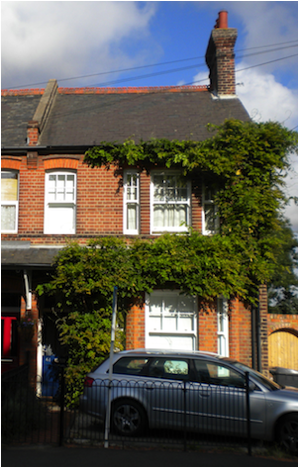
Leo was born at 6 West End Terrace (today’s number 101), South Primrose Hill, Chelmsford on 1st April 1892, the second son of James Gainsford Dixon and Alice Emma Dixon (nee Creasy). His father had been born on 18th November 1864 in Chelmsford; his mother in 1863 in Rawreth.
They had married in 1887 and by 1891 had been living at 6 West End Terrace at which point Leo’s father was a tailor’s assistant.
Leo was baptised at London Road Congregational Church, Chelmsford on 31st July 1892. His sister Eva Carrie Creasy Dixon, who had been born in Chelmsford on 1st June 1889, was baptised the same day. They also had siblings Gainsford Daley Dixon (1888-1963), Eva Carrie Creasy Dixon (born 1st June 1889, died 1922) , Leslie John Dixon (1894-1895), and Lancelot James Dixon (born on 19th June 1897, died 1963), all born in Chelmsford.
On 1st November 1895 Leo’s father, would ultimately see him serve as Mayor of Chelmsford, was elected for the North Ward, ‘the first working men's candidate to be so elected.’
The 1901 census found Leo aged nine living at his father’s shop at 15 Duke Street, Chelmsford, accompanied by his father (a master tailor and outfitter), his mother, three siblings, and Leo’s grandmother, 77 year-old Emma Creasy. The shop is pictured below.
Leo undertook his elementary education at the Friars Council Boys’ School in Friars Place Chelmsford (now demolished). On 21st January 1904, when aged 11, he joined the 2nd Form at King Edward IV’s Grammar School, Chelmsford as a day scholar, the fees being paid by the County Council. At the time Leo was still living at 15 Duke Street, and his father was described as a master tailor.
On 20th November 1915 Leo attested at Chelmsford to join the Essex Regiment as a Private. At the time he was 23 years and seven months old, employed as a school teacher and living with his family at 12 Park Avenue (today’s number 61, pictured). He was given a service number of 5955 which was later renumbered as 6548 and then 202517. He was initially placed in the reserve and not mobilized until 8th February 1916 when he was posted to the 3/6 Battalion..
On 1st September 1916 Leo was posted upon reorganisation to the 4th (Reserve) Battalion of the Essex Regimenet, and within the month was .appointed unpaid acting Lance-Corporal.
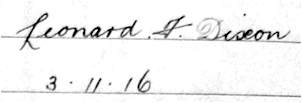
On 3rd November 1916 Leo completed his application form to obtain a commission as an officer. The form gave his home address as ‘Lynholm’ in Park Avenue, Chelmsford. His address for correspondence was Hut 13, H Lines, D Company, 4th Reserve Battalion, Essex Regiment, Halton Camp. The Minister at London Road Congregational Church in
Chelmsford also signed the application form, confirming that he had know Leo for five years and that he was of the necessary moral character to become an officer. Thomas Hay, the Head at King Edward VI Grammar School also signed to confirm that Leo had attained the necessary standard of education.
Leo passed a medical the same day which described him as five feet nine inches tall, weighing 11 stone 9 pounds, with chest measurements of 38 inches(maximum” and 34.5 inches (minimum).
The December 1916 edition of the King Edward VI Grammar School’s magazine, The Chelmsford Magazine, reported:
“Dixon, with whom we had a fine chat in the train lately, has been home on his last leave and expects to go to the Somme.”
On 8th January 1917 Leo’s commanding officer of the 4th Battalion, Essex Regiment, formally recommended that he be considered for a commission.
Le.o was appointed Lance Corporal with pay on 24th February 1917 and then Acting Corporal on 12th April 1917. On 5th May 1917 he was attached to Number 2 Officer Cadet Battalion at Cambridge ‘for instruction with view to appointment to Commission.’
Finally he was discharged from the Essex Regiment on 28th August 1917 as Acting Corporal, his application for a Commission having been successful. News of the granting of his Commission appeared in the London Gazette on 17th September 1917. Having not yet left England, he was posted to the 11th Battalion of the South Wales Borderers. He was subsequently attached to regiment’s 2nd Battalion, part of the army’s 29th Division.
Leo’s cousin, Charles Edward Gainsford Dixon, son of Charles Gainsford Dixon of Rayleigh, was killed in action on 2nd November 1917, aged 29, in Gaza while serving with the 1st/7th Battalion of the Cameronians (Scottish Rifles).
Leo was killed in action on 21st May 1918, aged 26. He was buried at Cinq Rues British Cemetery, Hazebrouck, Nord, in France (Grave reference: D.25). The cemetery was used chiefly by the field ambulances and fighting units of the 29th Division from April to August 1918 for the burial of Commonwealth casualties sustained during the German offensive. There are now 226 First World War burials in the cemetery.
News of Leo’a death came in a telegram dated 27th May 1918.
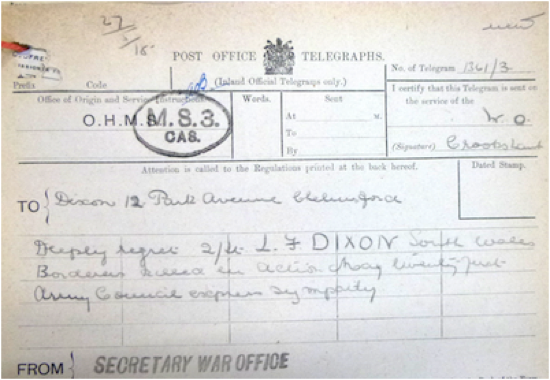
On 31st May 1918 the Essex County Chronicle included the following family announcement (which also appeared in the day’s Essex Weekly News):
“Dixon. - Killed in action, on May 21st. Leonard F. Dixon, 2nd-Lieut, South Wales Borderers, the dearly loved second son of Mr. and Mrs. J. G. Dixon, of 12 Park Avenue, Chelmsford, aged 26. ‘The will of the Lord be done’.’”
The same edition also reported:
“Sec.-Lt. Leonard F. Dixon, South Wales Borderers, second son of Mr. Councillor J. G. Dixon, of Chelmsford, was killed in action on May 21. The deceased, who was of fine physique, was on the teaching staff of Trinity Road Council Schools, Chelmsford, and was very popular. He was educated at Chelmsford Grammar School and Isleworth College, and had served at Writtle and Upminster Elementary Schools, being for over two years at Upminster. He was keen at athletics, and had won numerous prizes. At cricket he had several times made over 90 runs, but never reached the century. He joined the Essex Regt. in Feb. 1916, and after rising to the rank of corporal, he went to a Cadet School and received his commission last September, going almost at once to the Front. Lt. Dixon was 26 years of age. His Company officer, writing to the deceased’s father says: ‘His loss to one is more than that of a fellow officer. We were at the Cadet School together, in the same college, and came out to France together. It is no figure of speech when I say he died a glorious death. We were doing a stunt, and he was leading a party of his men. He gained his objective, leading his men with the same steady, cheerful courage he always showed, and was killed after he had finished his work, by a stray Bosche bullet.’”
The day’s Essex Weekly News reported:
“Sec.-Lieut. Leonard F. Dixon, South Wales Borderers, killed in action on May 21, was the second son of Mr. J. G. Dixon, of Park-av., Chelmsford, a member of the Town Council and other local bodies. Lieut. Dixon, who was a teacher in the Trinity-rd. Council School, Chelmsford, enlisted in the Essex Regt. in February, 1916. He reached the rank of corporal, and was then granted a commission. He underwent his training as an officer at Wendover, and was afterwards attached to the South Wales Borderers, proceeding to France on Good Friday.
On the night he met his death he was engaged upon a ‘stunt’, leading a party of his men. His captain writes: ‘He led his men with the steady and cheerful courage he had always show’. The objective was attained, but unfortunately just afterwards Lieut. Dixon was killed by a stray bullet.
The captain, who by a coincidence was at the same training college with Lieut. Dixon, writing to his father, states that the deceased officer was with the company on a short time, but his name will live for many a day; and he concludes by saying that he regrets the loss of not only a gallant officer, but a very dear friend. Lieut. Dixon was very popular at Trinity-rd. School, and was a very fine cricketer. Full of spirit, he was a most agreeable companion, as well as a smart soldier.
On Tuesday at the meeting of the Chelmsford Borough Food Control Committee the Chairman, Mr. J. O. Thompson, proposed a vote of sympathy with Mr. J. G. Dixon and his family in the loss they had sustained; and this was carried. A similar resolution was adopted in silence by the Town Council on Wednesday, being proposed by the Mayor, Councillor, J. Gowers, and seconded by Alderman Thompson.”
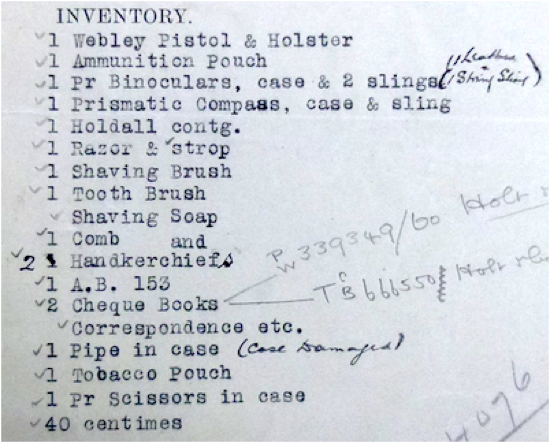
The July 1918 edition of the King Edward VI’s Grammar School’s publication, The Chelmsford Magazine, reported:
“Leonard Frederick Dixon. 2nd Lt. South Wales Borderers, was killed in action, in France, on May 21st 1918. He was 26 years old and many of us remember him as a bright and hearty fellow with whom it was always a pleasure to have a chat.”
Leo is commemorated on the Civic Centre Memorial, Chelmsford, by the Chelmsford Parish Great War Memorial in Chelmsford Cathedral. and the King Edward VI Grammar School Memorial in Chelmsford. Leo is also commemorated on his family’s grave at the Borough Cemetery in Writtle Road, Chelmsford (pictured)
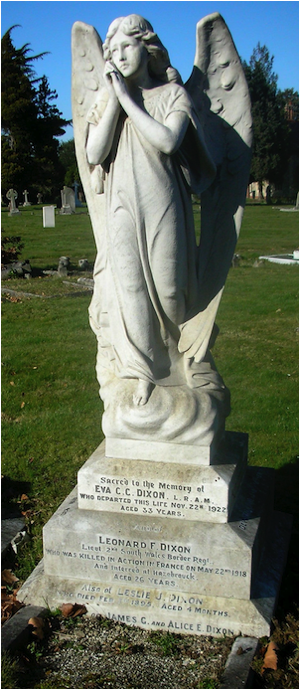
He was entitled to the Victory and British War medals. He left an estate valued at £257 16s.
Leo’s brother Gainsford served in the Royal Engineers.
The 1918 register of electors listed Leo’s parents at 12 Park Avenue, Chelmsford (later renumbered as 26 and today as 61).
Leo’s father (pictured below) was a Borough Councillor in Chelmsford between 1895 and 1899, and again between 1906 and 1921; he became Mayor of Chelmsford in 1919-1920 and is remembered by Dixon Avenue on the Boarded Barns Estate, Chelmsford. He died on 15th May 1937, aged 72, leaving an estate valued at £6936 9s. 7d.. On 22nd May 1937 the Essex Newsman reported:
“DEATH OF MR. J. G. DIXON EX-ALDERMAN AND A FORMER MAYOR OF CHELMSFORD
We regret to record the death, which occurred at his residence, Lyndholme, Park Avenue, Chelmsford on Sunday, of Mr. James Gainsford Dixon an ex-Alderman and a former Mayor of Chelmsford. He had been in ill-health for some time, suffering from heart trouble
Mr. Dixon's death will recall his dramatic retirement from the Chelmsford Town Council in November 1935. In that month he sent his resignation to the Clerk of the Council, Mr. G. E. Barford, as "a protest against Council proceedings over a notice of motion regarding the Council's decision on July 31 to increase the then Sanitary Inspector's salary by £50 per annum." Mr. Dixon was one of five members of the Council who signed a notice of motion to rescind the Council's resolution of July 31, the same not having been considered by the Finance Committee in accordance with Standing Order 94." When the matter came up at the subsequent meeting of the Council, the Town Clerk said the notice of motion was bad, and Mr. Dixon was ruled out of order. He nevertheless contended that he was in order, and said later, "If we do not see that the standing orders are carried out, have no right to continue as members of the Council." He then sent in his resignation, and the Town Clerk accepted it as taking effect immediately, by virtue of Section 62 of the Local Government Act, 1933.
Mr. Dixon thus retiring, had been connected with the Chelmsford Town Council since Nov. 1st 1895, when he was elected for the North Ward, the first working men's candidate to be so elected. Through business ties he was prevented from seeking re-election, but in 1906, when a vacancy was caused by the death of Cr. E. Lawn, Mr. Dixon returned to the Council.
In February, 1921, he was elected an Alderman to fill the vacancy caused by the death of Ald. Albert Driver.
He was Mayor of the Borough in 1919-20, and among his duties was that of welcoming many Chelmsford ex-Service men on their return from the war.
He was for many years chairman of the Housing Committee of the Council, and had much to do with the development of the Boarded Barns Housing Estate, and he will be remembered for his vigorous opposition to the proposal to put licensed premises on the estate. He was a staunch teetotaler, and noted for his outspoken views.
In his younger days he was capable cricketer, playing for the Chelmsford Y.M.C.A., and he always maintained his interest in the game.
Mr. Dixon was 72, and a native of Chelmsford, he had lived there practically all his life. He was in business as a tailor and outfitter for over thirty years before he retired.
He had been associated with the Baddow Road and North Avenue Congregational Churches, and was keenly interested in
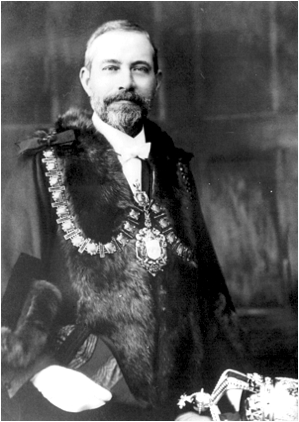
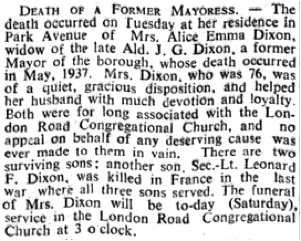
Sunday School and temperance work, as in the welfare of the Essex Home School His wife and two sons survive.
Another son, Lieut. Dixon, was killed in action in France in May, 1918, while serving with the South Wales Borderers, and a daughter. Miss Eva Dixon, died in 1922.
The funeral of Mr. Dixon took place at Chelmsford yesterday, interment in the Writtle Road Cemetery being preceded by a service in the London Road Congregational Church.”
Leo’s mother died in 1939, aged 76, leaving an estate of £182 9s. 5d.
In 1944 Leo’s nephew, Leonard Frederick Gainsford Dixon, died having seen service with the Fleet Air Arm.
131005